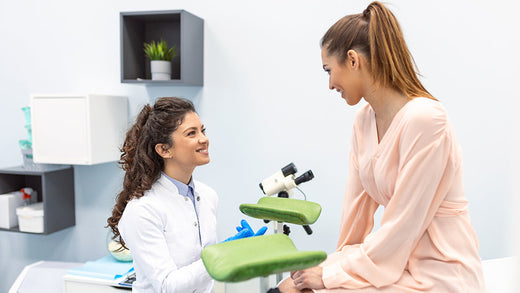How Is Cervical Cancer Diagnosed?
Find out moreWhen detected in its earliest stage, around 95% of people diagnosed with cervical cancer will survive for five years or more.
In this article, we discuss cervical cancer, what causes it and the various ways that cervical cancer can be diagnosed.
What is cervical cancer?
The cervix is a part of the female reproductive system that forms the opening between the vagina and the womb. Cervical cancer is when abnormal cells grow unchecked in the cervix lining, eventually forming a tumour.
The main symptom of cervical cancer is unusual vaginal bleeding — including bleeding during or after sex, heavier periods than usual, and bleeding between periods or after menopause.
Other symptoms to look out for that could be a sign of cervical cancer include:
- Pain or discomfort during sex
- Changes to vaginal discharge
- Pain in the lower back, pelvis or lower tummy
These symptoms are common and may be caused by many other conditions, such as fibroids or endometriosis; having them doesn’t necessarily mean you have cervical cancer. However, it is important to get any symptoms of cervical cancer checked as soon as possible.
Some women with cervical cancer will have no symptoms, which is why it’s essential to have regular cervical cancer screening tests.
According to Cancer Research UK, cervical cancer is the 14th most common cancer in females in the UK, with around 3,200 women diagnosed each year. It is most common in women in their early 30s.
What are the causes of cervical cancer?
An infection of human papillomavirus (HPV) causes almost all cervical cancer cases.
HPV is very common and there are several types. Most HPV types are harmless, but around 13 variants are considered high risk for cervical cancer.
In most cases, the body’s immune system will clear an HPV infection within two years. However, if this doesn’t happen and there’s a long-term infection with a high-risk type of HPV, this increases the risk of developing cervical cancer.
You can be infected with HPV via any skin-to-skin contact with the genital area, through vaginal, anal or oral sex, or by sharing sex toys.
For more information, please refer to our article HPV and cervical cancer, where we ask the expert Mr Jullien Brady the differences between the two.
Risk factors for cervical cancer
As well as the human papillomavirus, several risk factors may increase your chance of having cervical cancer, including:
- Age – cervical cancer is most common among younger women, with more than half of cases diagnosed in the UK being in women under 45.
- Smoking – the risk increases the more tobacco you smoke a day and the younger your age when you start smoking.
- Having children – women who have given birth to multiple children or gave birth at a young age are at higher risk.
- Taking the contraceptive pill – 1 in 10 cervical cancer cases is linked to taking the contraceptive pill.
- Family history – your risk is higher if your mother, sister or daughter has had cervical cancer.
- Having HIV or AIDS – a weakened immune system due to HIV or AIDS increases your risk of developing cervical cancer.
You cannot always change these risk factors and prevent cervical cancer. HPV tests are one of the best ways to protect yourself from cervical cancer.
How is cervical cancer diagnosed?
As with any type of cancer, early detection is the key to successfully treating cervical cancer and longer survival.
NHS Cervical screening
In the UK, the NHS invites all women between the ages of 25 and 64 to have regular cervical screenings. Cervical screening aims to check for HPV and treat any abnormal cells in the cervix before they become cancer. Screening can also identify cervical cancer that has already developed.
Cervical screening is straightforward. Your nurse will ask you to lie on your back with your clothes off from the waist down. Then, with your knees spread apart, the nurse will gently insert a speculum into the vagina to open it up until they can see your cervix.
The nurse will then use a soft brush-like tool to take samples of cells from the surface of your cervix to be sent to the lab. The screening may be a little uncomfortable but only lasts for one or two minutes.
If your test comes back negative for HPV, you need no further testing until your next screening in a few years. If you test positive for HPV, you may be asked to return for a colposcopy procedure.
Colposcopy
A colposcopy will be done if you have cervical cancer symptoms, and may be done in some cases if you test positive for HPV and your GP wants to investigate further.
The procedure allows your doctor to take a closer look at your cervix to check for cervical cancer.
During a colposcopy, you’ll lie on your back with your legs apart. The doctor will then insert a speculum and insert a magnifying instrument called a colposcope to take a closer look at your cervix. The procedure allows your doctor to spot any minor changes that would not be seen by the naked eye and take biopsies of any abnormal areas. The examination takes around 20 minutes.
Biopsy
A biopsy is where a small tissue sample is taken and sent to a lab for analysis. In diagnosing cervical cancer, several biopsy types may be done:
- Punch biopsy – uses a circular blade to remove a sample of tissue from the cervix. One or more punch biopsies may be done to take samples from different cervical areas.
- Endocervical curettage – collects cells or a small sample of tissue from the cervical canal using a spoon-shaped instrument called a curette.
- Cone biopsy – your doctor will use a laser or scalpel to take a cone-shaped piece of tissue from your cervix and cervical canal. They can use this biopsy to diagnose cervical cancer or remove pre-cancerous cells or early-stage cancer. A cone biopsy is done under general anaesthetic.
- Loop electrosurgical excision procedure (LEEP) – under local anaesthetic, an electrical current is passed through a thin wire loop to remove tissue from the cervix. The aim is to diagnose cervical cancer or remove pre-cancerous cells or early-stage cancer.
Can ultrasound detect cervical cancer?
Doctors can use ultrasound to detect some types of cancer, but it is not often used in diagnosing cervical cancer, as it can rarely be seen on ultrasound images.
They may use ultrasound on other body areas after a diagnosis of cervical cancer has been made to see if it has spread to other regions.
How is cervical cancer treated?
Treatment for cervical cancer depends on the stage at which it’s diagnosed. Generally, the earlier the disease is diagnosed, the more effective and less invasive the treatment.
The most common treatments for cervical cancer include:
- Surgery
- Radiotherapy
- Chemotherapy
- Targeted therapy
- Immunotherapy
How to test for HPV at home
At Check4Cancer, we want to empower you to take control of your health. We’re committed to providing clinical excellence in all our cancer screening and diagnostic services.
Our Cervical Cancer Screening Test is an easy-to-use, comfortable and reliable at-home test kit that looks for the human papillomavirus (HPV), the virus that causes cervical cancer.
Once you have completed the sample collection kit and returned the sample to our laboratory, our team of specialists will analyse your test results and provide you with a personalised screening programme.

Jullien Brady
Clinical Advisor for Cervical Cancer
Consultant Gynaecologist. Professional Clinical Advisor for Colposcopy for Public Health England. Member of the Executive Committee of the BSCCP. Jullien Brady has an international reputation as a leading expert in the field of colposcopy and cervical screening. He is a former National Quality Assurance Director for the NHS Cervical Screening Programme and Professional Clinical Advisor for Colposcopy for Public Health England. He was a member of the Executive Committee of the BSCCP, the governing body of Colposcopy for over a decade. Mr Brady is passionate about women having the opportunity to maximise their health choices and screening options.
Find out moreKnowledge and support
Go to all articles
HPV Awareness Day
The International Papillomavirus Society (IPVS) established March 4th as HPV Awareness Day, in 2018. It provides an opportunity to highlight...
Read more
What is HPV and What are the Symptoms?
Understanding HPV, how it spreads, its symptoms, and how to protect yourself is crucial for maintaining your health.
Read more
Does A Smear Test Hurt?
What happens at a smear test, does it hurt or not, what to do if you experience any side effects...
Read more